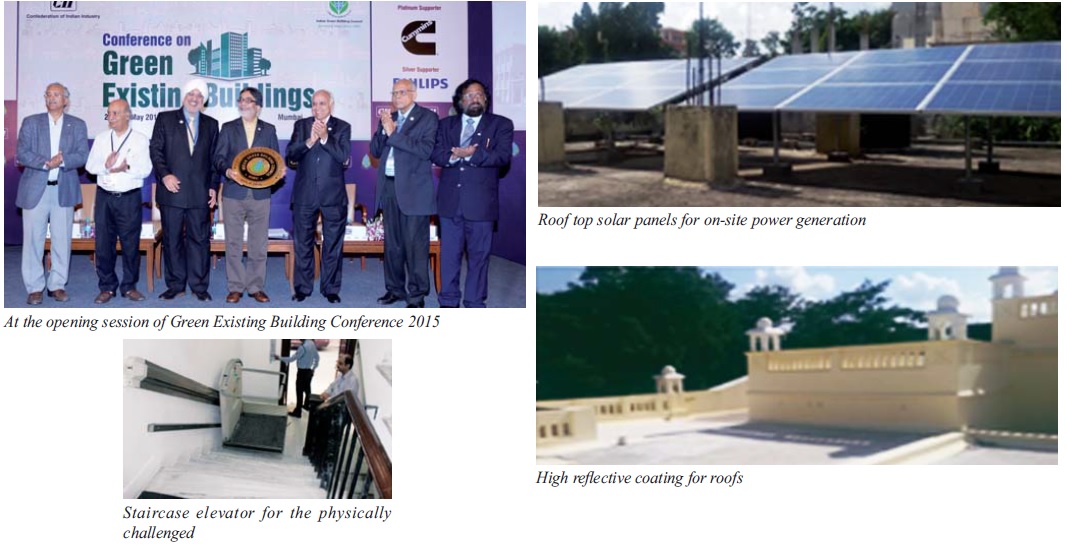News Details
Building Relationships – IGBC Green Building Rating Systems (May June 15)
11 September 2015
Introduction
Greening of existing buildings will go a long way towards addressing national priorities like conservation of natural resources, water efficiency, energy efficiency, handling of municipal waste and health and well-being of the citizens. It will enhance occupant health, happiness and well-being.
IGBC Rating System for Existing Buildings
Taking the above imperative forward, IGBC with the support of stakeholders, has launched India’s first Green Building Rating System for Existing Buildings. The overarching objective of this rating is to facilitate building owners and facility managers in implementation of green strategies, measure their impact and ensure sustained performance. The thrust is on implementation and results. Today, projects with over 9 million sq ft of footprint are going the IGBC way, and many more projects are in the pipeline.
Conference on Green Existing Buildings
In its efforts to accelerate the adoption of Green Rating by existing buildings in India, IGBC had organised a Conference on Green Existing Buildings on May 21-22 at Mumbai. The two-day conference focused on best practices in operation and maintenance; energy savings through retrofit and controls; water conservation; solid waste management; site and facility management; occupant health and comfort; and performance monitoring of buildings. Some of the features, shared at the Conference for the above focus areas, for Green Existing Buildings, are as follows:
Energy Savings through Retrofit and Controls
• Installation of roof top solar panels
• Clean AHU coils and install UV light upstream
• Upgradation of existing chillers for HVAC system
• Evaporative cooling for air-cooled condenser tubes
• Provision of wireless building automation system for HVAC
• Installation of digital energy meters to monitor energy use
Water Conservation
• Retrofitting water fixtures with aerators
• Ultra-low flow fixtures
• Dual flush cisterns for WCs
• Biological treatment of waste water through Phytoremediation
• Use of treated grey water for water and air cooled chiller
Solid Waste Management
• Segregation of solid waste and recycling
• Use of in-house generated organic fertilizers for landscaping
Site and Facility Management
• Building envelope assessment: thermal imaging of building facade to assess thermal leakages
• Transparent film of high SRI to minimize heat gain
• High reflective coating for roofs: 100% roof to be covered with paint having high SRI
• Enhanced Green spaces
Occupant Health and Comfort
• Eco-friendly housekeeping chemicals
• Recreational areas
• Facilities for differentlyabled people These are some illustrative green features that are being incorporated in existing buildings. There are many other innovative and futuristic technologies which will facilitate conservation of finite resources and, in the process, significantly improve the quality of life of the occupants.
Conclusion
Many projects have successfully implemented green retrofits to save resources and operating costs. In days to come, India will go a long way in greening existing buildings and setting new global benchmarks. Going the green way is not only good for Planet Earth, but also for the National Economy. It is estimated that by 2025, the retrofit potential of existing buildings in India would be about USD 25 billion. Concerted and collaborative efforts will facilitate a Greener and healthier India.
Disclaimer: The information provided within this publication / eBook/ content is for general informational purposes only. While we try to keep the information up-to-date and correct, there are no representations or warranties, express or implied, about the completeness, accuracy, reliability, suitability or availability with respect to the information, products, services, or related graphics contained in this publication / eBook/ content for any purpose. Any use of this information is at your own risk.
 Youth
Youth
 Women
Women
 Research for Ishrae
Research for Ishrae







